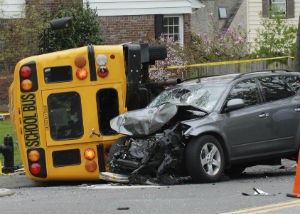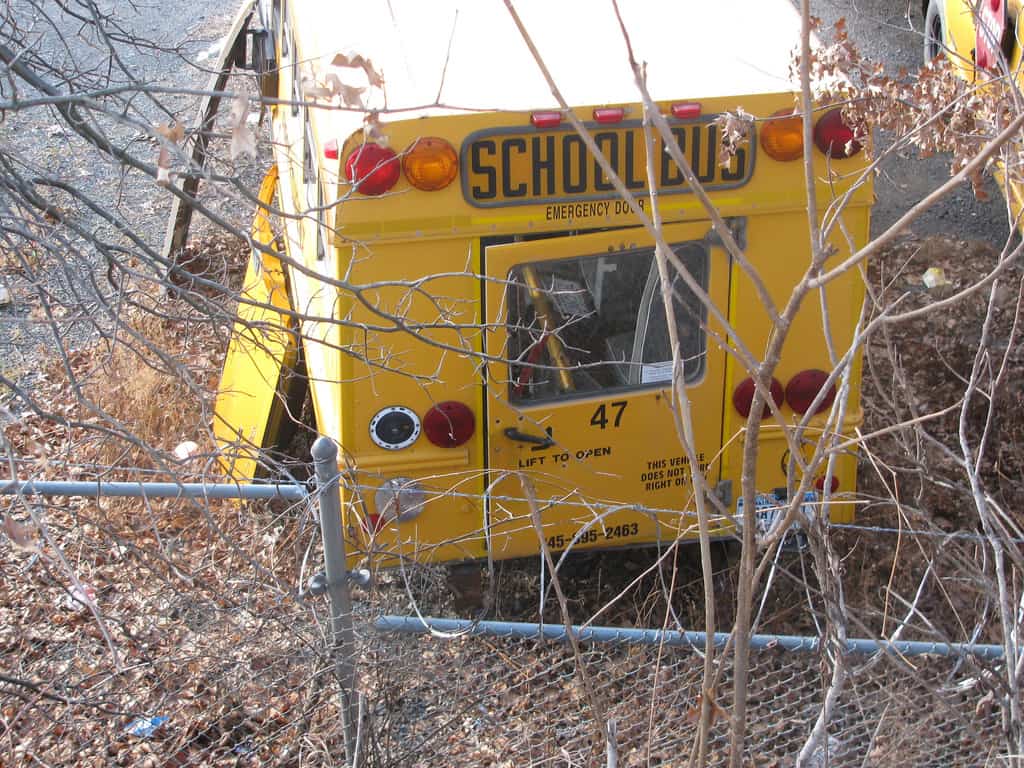 Eight people have reportedly been injured in a Chicago school bus crash involving a tree branch. While the full picture of what happened may still be forthcoming, this incident raises an important question: Who would be financially responsible for a passenger’s injuries in a school bus crash?
Eight people have reportedly been injured in a Chicago school bus crash involving a tree branch. While the full picture of what happened may still be forthcoming, this incident raises an important question: Who would be financially responsible for a passenger’s injuries in a school bus crash?
An Avondale Branch
The school bus crash in question took place on October 18, 2017. At approximately 2:55 p.m., the school bus was traveling at or near the 2900 block of North Central Park Avenue in Chicago’s Avondale neighborhood on the Northwest Side. The school bus then apparently crashed into a tree branch, shattering the vehicle’s front windshield.
The school bus was said to have been carrying 44 schoolchildren at the time of the crash. Eight of the school bus’s passengers were taken to an area hospital for evaluation, according to the Chicago Fire Department. It is unclear whether all of them were children. The remaining passengers were reportedly transferred to another school bus for the remainder of the route.
A Relationship Built on Trust
At its core, the relationship between school bus systems and the parents and children that they serve is built on one thing: Trust.
Nearly every day, parents place the safety of their children in the hands of school bus drivers. They trust these strangers to care for their children when they cannot. They trust that these drivers are trained, licensed, and have the knowledge and the skills to get these children to school and bring them back home unharmed. Parents also trust that the school buses themselves are properly maintained and in good condition, with no mechanical defects that can make the bus fail when it can least afford to do so. It is on this foundation of trust – so simple, so unspoken, and yet so essential – that America secures its future.
But what if this trust is betrayed? What if there is a school bus crash, and a child is seriously hurt or even killed? Who is responsible? Who will compensate the family for medical bills or the loss of a child?
With school buses, as with other mass transportation vehicles, the answer isn’t always so obvious. The following is a brief (though by no means exhaustive) introduction about legal responsibility in school bus crashes.
Multiple-Vehicle School Bus Crash Liability
To state the obvious, school buses are mass transportation motor vehicles. They are designed to carry multiple passengers, typically children, to and from destinations, and to do so, they travel on roads, where they interact with other motor vehicles and their drivers. Most school bus trips – like most other types of motor vehicle trips – are uneventful. Unfortunately, sometimes a school bus trip – again, like any other type of motor vehicle trip – can be cut short by a collision with another vehicle or vehicles, potentially causing serious injury to school bus passengers.
When such a collision happens, who is financially responsible? The answer depends on who is determined by law enforcement to be responsible for the school bus crash. The at-fault party could be…
• The School Bus Driver – If the school bus driver engaged in negligent actions that led to a collision with another vehicle or vehicles, that driver will likely be determined to be the at-fault party. In seeking financial compensation for a child passenger’s injuries, the family would likely pursue the school bus driver and/or his or her employer, whether that be the school, the school district, a contracted private bus company, or some combination thereof. However, a subsequent investigation may determine that the at-fault party was…
• The Other Driver(s) – In this scenario, another vehicle or vehicles may have crashed into the school bus or engaged in some negligent action that caused the school bus driver to crash into the other vehicle(s). In this case, the injured child’s family would typically seek financial compensation from the liability insurance carrier(s) of the other driver(s).
Single-Vehicle School Bus Crash Liability
What about cases in which no other vehicle was involved, cases in which the school bus driver crashed into a stationary object, like a tree branch or a utility pole, or in which he or she drove off of the roadway and crashed into a ditch or some other obstruction? Such single-vehicle school bus crashes would be typically treated in the same way as a two-vehicle crash in which the school bus driver was determined to be at fault. That is, the family may seek compensation from the driver, the school, the school district, a private bus company, or some combination thereof.
There is, however, another possible avenue of recovery in cases wherein the school bus is the at-fault vehicle, and that is when the crash was determined to be the result of a mechanical defect in the bus itself.
If a school bus defect resulted in a crash that injured a passenger, the manufacturers, suppliers, designers, and other parties involved in producing the school bus can be held accountable through Illinois product liability litigation. Defects can occur in any stage of school bus production, from design and development to assembly, so it is important to identify all responsible parties. Failure to do so in a timely fashion could forever bar injured parties from obtaining the financial compensation they deserve.
Illinois School Bus Crash Lawyers
A school bus crash is a traumatic event, one that threatens what a family holds most dear: a child. For this reason, many families find that they may benefit from the guidance of an experienced school bus crash lawyer to help them get the financial compensation that they deserve, like the Illinois school bus crash lawyers at GWC Injury Lawyers, Illinois’ largest Personal Injury and Workers’ Compensation law firm.
If you or a loved one has been injured, in a school bus crash or in some other way, please contact GWC today to schedule a free consultation with one of our attorneys. Call our office at (312) 464-1234 or click here to chat with one of our representatives.
<< BACK TO BLOG POSTS